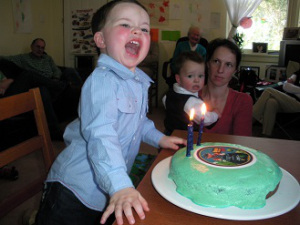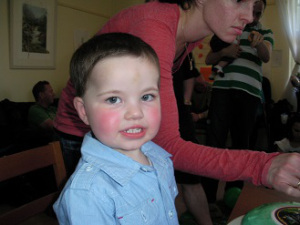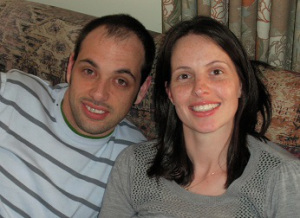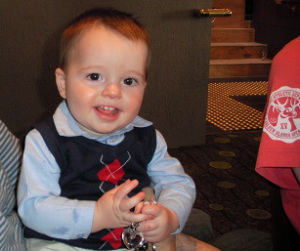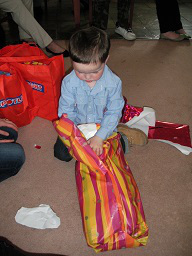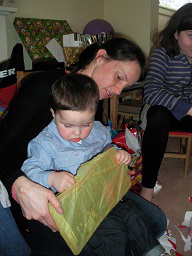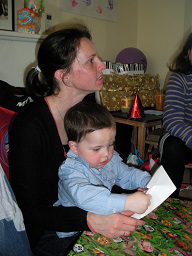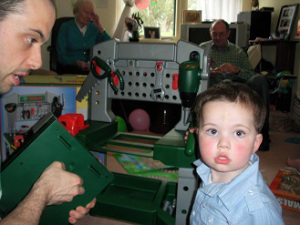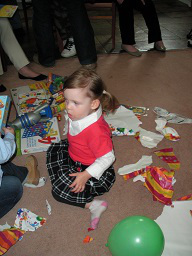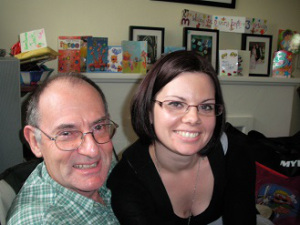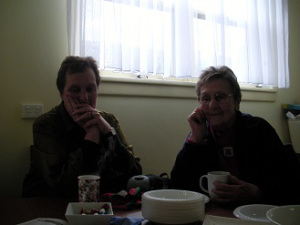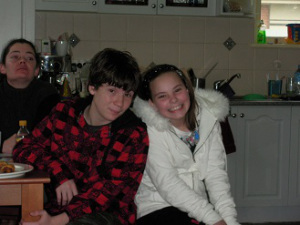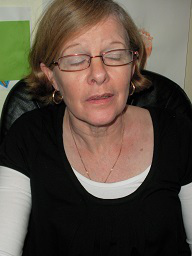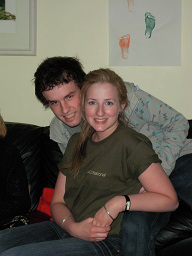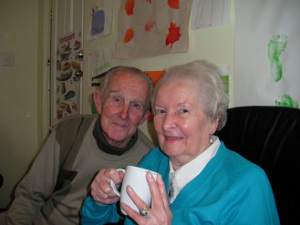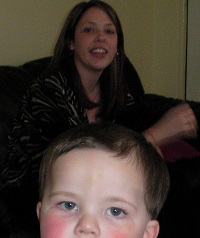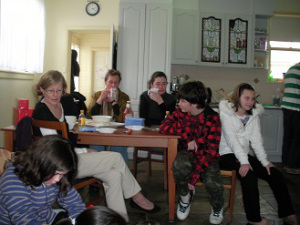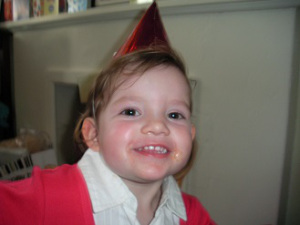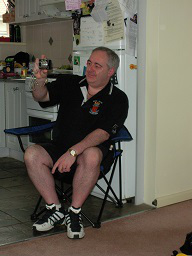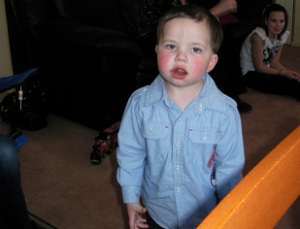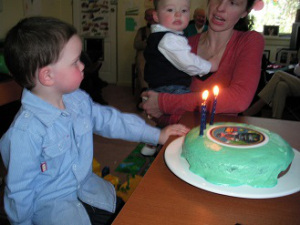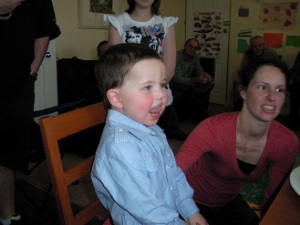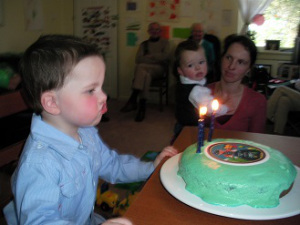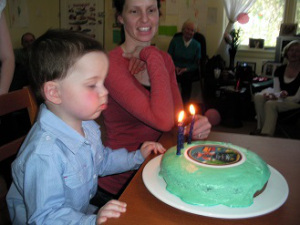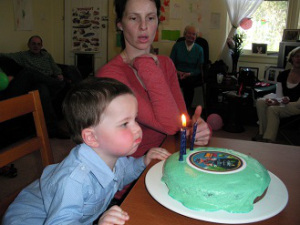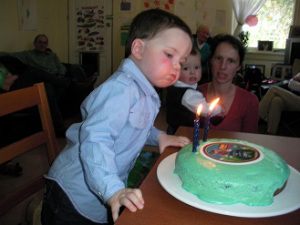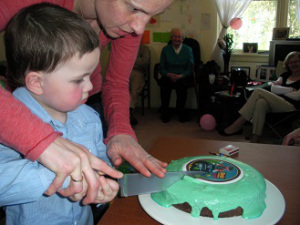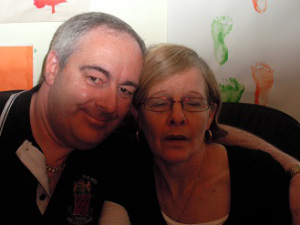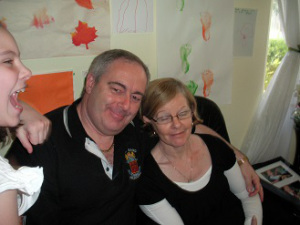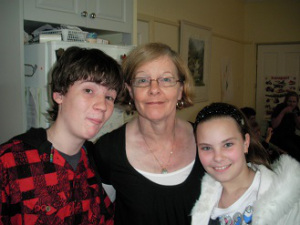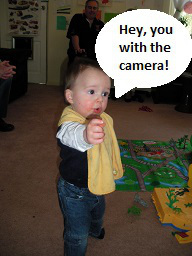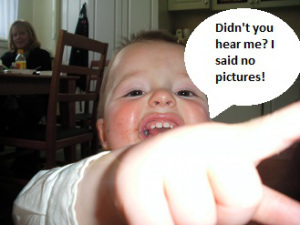L.E. Truscott's Blog, page 38
February 4, 2016
Jack’s Birthday Party
In 2009, I attended a birthday party for my nephew, Jack, who was turning three. I took plenty of pictures and in the following weeks when I reviewed them, I didn’t just see memories, I saw a story. The following was the result.
Jack’s Birthday Party
by
Aunt Louise
Once upon a time, there was a little boy named Jack.
Jack’s daddy was Ben. Jack’s mummy was Natalie.
Jack’s brother was Rhys.
For Jack’s birthday, his daddy and mummy decided to have a party with presents…
…and more presents…
…and more presents…
…and more presents. There were so many presents…
…that Jack needed help unwrapping them all. So his cousin Ava helped.
There were lots of people at Jack’s birthday party. There was his Papa and his Aunt Steph…
…there was his Nana Jenny and Grandma Gwen, who had come from a long way away…
…there was his Aunt Michelle, his cousin Mikey and his Aunt Genevieve…
…there was his Nana Jill, although she was a bit sleepy…
…there was his Aunt Liz in her school uniform and Liz’s boyfriend, Tim…
…there was his Gran Nan and Gran Pa…
…there was his Aunt Anna…
…there were so many people!
There were coloured party hats…
…and people taking pictures, like Alan and Aunt Louise.
There was even chocolate!
Soon it was time to sing the birthday song and blow out the candles on the cake.
“Happy birthday to you, happy birthday to you, happy birthday dear Jack, happy birthday to you.”
Jack blew…
…and blew…
…and blew…
…and blew…
…until all the candles went out and it was time to cut the cake and eat it.
Parties can be very tiring. Nana Jill was sleepy at the beginning…
…Nana Jill was sleepy in the middle…
…but Nana Jill woke up in time to have lots of fun at Jack’s birthday party.
Rhys had lots of fun, too.
The End.


February 2, 2016
One Year Ago Today, A Little Blog Was Born
It was one year ago today that I created and posted my first blog. Since then, I’ve posted 166 times (with plenty more scheduled for the future), I’ve had 1,710 views, 883 visitors and 292 likes. The majority of my readers are in Australia and the US but I’ve also been read by people from the UK, Canada, New Zealand, Bangladesh, India, the Philippines, Ireland, Vietnam, Finland, Malaysia, Hong Kong, and several handfuls of other countries.
I’ve written more in the past year than I’ve ever written before and having this blog is the reason why. Because I’ve set myself goals and I’ve managed to stick to them, posting a book review every Monday (excluding the month of Project October, which you can read about here, here, here, here and here ) as well as blog posts on various writing related topics and samples of my creative writing with the occasional guest post thrown in.
In the tradition of all good writers who want to rest on the laurels of all their previous hard work and have reached a milestone that is as good an excuse as any, here are some of the highlights of Year One.
The One Book I Can’t Live Without
A guy at work, upon seeing me with my Macquarie International English Dictionary, engaged me in conversation and asked, “Is that yours? Did you bring it from home?” Within minutes, he regretted ever having started the discussion and called me a word nerd (although only after confessing to being a bit of a word nerd himself – his three contributions to our chat were conflate (the original versus the newer meaning), dendrochronologist (which he used to befuddle his son) and inculcate (which he professed a liking for), all quite nice contributions, I must admit).
Read more here…
The Distraction of Other Writing
I’ve now spent a lot of time learning how to blog, setting up the blog, writing blog posts with brand new material, searching out old material and scheduling posts so that they appear each day at the same time. And I’ve spent exactly no time writing the novel that I am currently in the middle of constructing. This writing is distracting me from that writing. In fact, it’s more than distracting me. It’s making me ignore my novel-in-progress completely.
Read more here…
A Million Excuses Not to Write
Enough of the waffle. Just write. And eventually your writing will be good enough. One day it might even be great. But giving up before you get there is just one more excuse.
Read more here…
The Ideas Generator
As I was trying to sleep one night (which is when almost all good ideas strike), I had an idea for how to generate ideas. It’s a seven-step process that can be applied to a lot of stories already out there, which is why I think it will work for developing new stories.
Here’s how it works in a nutshell. You pick a genre. You pick a main character. You give them a past traumatic incident. You pick a second main character or a secondary character for the main character to interact with. You give the main character a profession. You introduce a trigger to add drama. And then you add an ending.
Read more here…
One Bad Review
In an attempt to get more sales and more reviews, I added Enemies Closer to the Goodreads (link) website and ran a couple of on-site advertisements. It has been added to reading lists a couple of dozen times and at the end of 2014, I finally received my first Goodreads review. Sort of. No words. No explanation. Just a one star rating. Anyone familiar with Goodreads will know their star rating system is pretty generous. Even two stars means “it was okay”. But one star is definitively a bad rating.
Read more here…
So You’ve Decided to Make Your Main Character a Writer
Okay, so I couldn’t talk you out of making your main character a writer. But maybe I can talk you out of making your writer character a bad stereotype. So do me a favour and avoid the following character traits seen so often in clichéd fictional versions of ourselves.
Read more here…
A Hopefully Helpful Lecture from a Spelling, Punctuation and Grammar Nazi
Writers who struggle with spelling, punctuation and grammar must get frustrated by the constant corrections from well-meaning editors who bemoan the fact that they never seem to learn. The truth is writers who struggle with these areas will never improve without some tips, tricks and suggestions more useful than an instruction to simply start “getting it right”.
Read more here…
Plot Clichés You Should Avoid Like the Plague
This has happened to everyone so often it’s a plot cliché in itself. You’re watching a TV show or a movie or reading a book and instead of being surprised by what happens next, it has you rolling your eyes either because you saw it coming a long way off or because you’ve seen the exact same plot point in about a thousand other TV shows, movies and books.
Read more here…
Advice to an Almost Famous Author
Your opinions don’t matter more, you will just be asked for them more often. Being famous means more people will ask you questions and more people will listen to your answers. It’s very important to remember that success in one area does not make you an expert in others.
Read more here…
The Benefits of an Ideas Board
As writers, we can sometimes lose sight of the little things that help make writing easier. My big picture was to write a lot of blog posts. But the small step of buying and implementing the ideas board is what has helped me to do it. Here’s why.
Read more here…
Confessions of a Reformed Perfectionist: Is “Good Enough” Good Enough?
When you think your piece is a three out of five, that’s when you ask your beta readers for their opinions. And then you rework it. When you think your piece is a four out of five, that’s when you pay a professional manuscript assessor for their opinion. And then you rework it. And when you think your piece is a five out of five, that’s when you pay a professional editor to find and fix your errors. And then it’s ready to be sent to publishers. If you’re lucky enough to attract any interest, despite you thinking it’s a five, the publisher will still think it’s only a four and want to guide you as you rework it yet again. And maybe again after that.
Read more here…
There are plenty more posts (155 of them, in fact) so please explore them at your leisure if you haven’t already. And here’s to another year of writing. Cheers!


January 31, 2016
Book Review: The Burning Room by Michael Connelly
Apart from Michael Connelly’s 2015 release, The Crossing, I’ve read every single one of his novels (and I’ll eventually read The Crossing, too, when I get around to it). Connelly’s greatest attribute is his consistency. His books are consistently well-written. His characters are consistently interesting and consistently but appropriately flawed – just enough so that we know they’re on the good side of the good-bad divide but that they’re willing to explore their bad side if it means achieving the right result. And his plots are consistently logical with crimes that are consistently solvable.
I suppose the problem with all that consistency is that if you’ve read all of Connelly’s books, like I have, there’s little chance of being surprised.
The Burning Room finds Harry Bosch still working in the Open Unsolved Unit, this time with a new, young partner, Lucia Soto, who has distinguished herself by shooting dead two robbers and pinning down two others until back-up arrived after her former partner was shot dead in the exchange. She was celebrated in the media and given the choice of working in any department she wanted; she chose the Open Unsolved Unit.
But Lucia has never worked homicide before so she is paired with Harry, the unit’s most experienced detective, in order to learn the ropes and quickly. There is quite a bit of lecturing from Harry while they investigate an unusual cold case. Unusual in that even though the crime occurred ten years ago, the victim only died in the last week. Orlando Merced was shot in an apparent drive-by but survived more than ten years with a bullet in his spine. Along the way, he became a celebrated anti-crime activist and when the coroner rules that it was the shooting that ultimately killed him, despite the length of time that has elapsed, the case falls into Bosch and Soto’s laps.
After Orlando’s death, they are finally able to retrieve the bullet from his body where it had remained since the shooting, unable to be removed without causing significant further damage. It’s the lead they needed and the detectives follow a very slow, very winding path to identifying why he was shot and by who.
The problem with having Harry work in the Open Unsolved Unit is that there is no sense of urgency to the crimes he is trying to solve. He and Lucia end up working another cold case at the same time and they solve both but most of those involved are dead and unable to be held to account for their crimes.
Connelly has almost written his main character into a corner. Harry’s getting old. It’s only a year until he retires and it’s almost like he’s treading water. He’s long since stopped evolving or having epiphanies of any description. After all, Connelly has another character and another series for that, with Mickey Haller of Lincoln Lawyer fame.
At one point during the novel, Harry mentions that he doesn’t watch television or movies in the crime genre because they are all so obsessed with neat finishes where everybody gets their man and there’s a sense of resolution and closure. It’s just so unrealistic, he despairs. It’s probably true. The problem is that we don’t read crime fiction in order to get a dose of realism. We want well-plotted stories with motivated characters on both sides of the criminal divide and exciting stories that build to climactic endings.
Instead, what Harry (and Connelly) is giving us are crimes with stereotypical motivations and because he’s Harry Bosch, old school fool, there’s always a moment thrown in that sees him in trouble with the potential of again being thrown out of the force for what he considers minor indiscretions but the department considers a clear case of breaking the rules. Why does Harry never learn? Perhaps because he keeps getting away with it.
The most interesting character in the book is Harry’s daughter, Maddie. She appears only sporadically because Harry all but ignores her as he does his job during business hours and after hours. But she’s a crack shot as a sporting shooter, she’s involved in Meals on Wheels as well as the police Explorers, doing ride-alongs on the police beat and helping in underage stings, she’s going on dates (which Harry hates), and she’s doing well at school with the current intention of joining the police force just like her dad.
There’s nothing especially wrong with this book but there’s nothing especially interesting about it either. If it wasn’t for the presence of Harry Bosch, and all the cachet he brings with him, it would be considered just another crime novel. And since I don’t care about Harry’s cachet, as far as I’m concerned, it’s just another crime novel.
Connelly has been pretty consistent (there’s that word again) at producing a novel a year and considering Harry only has a year until he will retire, I guess that means one more book to send this beloved character off on a high (unless, of course, it just goes on and on and on until Harry’s solving nursing home mysteries like some kind of sad, male Miss Marple). I’ll continue reading Connelly’s books but I’m hoping for something in the next book that sees him resting less on the laurels of his characters and relying more on the reinvigoration of the stories that involve them.
3 stars
*First published on Goodreads 24 October 2015


January 28, 2016
Screen Scene: Fox Force Five
“Fox Force Five” is the name of the television show Uma Thurman’s character in Pulp Fiction shot a pilot for and even though it’s a tiny part of the movie, it got my mind churning all those years ago. I developed five disparate female characters and wrote introductory scenes for all of them.
The following is Khadija’s introductory scene. She was a kick-ass former military officer, an Israeli Arab and Mossad agent, who found herself teaching suburban and rural women self-defence.
I never really took it anywhere and this was written all the way back in 2001.
INT. OLD TOWN HALL – DAY
In a rural setting somewhere, sun seeps in through the dusty windows and falls on a group of women, dressed mostly in tracksuit pants. They are middle-aged, generic, blue-collar, but eager.
One woman, KHADIJA, stands apart. She is the instructor. Standing at the front of the class, she is dressed in tight aerobic style gear in military green. The clothing shows off her impressive physique and the unmistakeably military tattoo on her right upper arm. While the other women are sweating from the effort they have put into the class, Khadija is glowing with a subdued sort of happiness. She likes to feel in control. She loves the power that teaching this class gives her and loves that other women might feel the same sort of power from what they are learning.
KHADIJA
Ladies, we’ve got just a few more minutes.
There is a hint of a Middle Eastern accent when she speaks.
KHADIJA
(with emphasis, with expertise)
Let’s go back over the basics. Don’t wait until your attacker has you on the ground. Begin your defence the moment you feel under threat. Use your voice. Shout. What is it that you don’t shout?
LADIES
(collectively with vigour)
Help!
KHADIJA
Right. In a small country town like this, what do you shout if you want to get someone’s attention?
LADIES
Fire!
KHADIJA
Right. No self-respecting country boy is going to ignore shouts of “fire” when it could be his farm that’s going up in flames.
There are nods of agreement.
KHADIJA
But let’s consider another scenario. You’ve taken a trip to the city to…buy yourself a dress…
Buying dresses is obviously not something that Khadija knows anything about.
KHADIJA
…and some punk with a bad haircut and a worse attitude wants your purse. Most likely no-one cares if there’s a fire, and fewer people than that are going to care if your purse gets stolen. So it’s up to you.
Khadija looks around for someone to step onto the mat with her. She spies DIANE, who is obviously the woman with the most influence in the town.
KHADIJA
Diane, would you step up, please?
Diane does not hesitate but she possesses a sort of elegance that seems incongruous with what is about to be asked of her.
KHADIJA
So, Diane, it’s up to you.
Diane nods.
KHADIJA
I’m going to attack you, okay? Now, don’t be afraid to hurt me, because if it was the other way around, you know the son-of-a-bitch wouldn’t hesitate to hurt you.
Diane nods again.
A man, DARRYL, enters the room through doors at the front of the hall and stands watching with quite obvious contempt.
KHADIJA
(in a put-on vicious voice)
Gimme your purse, bitch.
DIANE
(with force)
No, you can’t have it. It’s mine. I won’t let you have it.
KHADIJA
Gimme your goddam money, or I’ll hurt you good.
DIANE
(as if to somebody nearby)
This woman is threatening me. I don’t know this woman. This woman is wearing green pants and a green top. This woman is threatening to hurt me.
KHADIJA
Shut up, bitch, or I’ll shut you up.
Khadija advances on Diane and Diane holds up her hand in the classic stop sign.
DIANE
Keep back, ma’am. Do not come closer. Take a step back.
The rest of the class watches intently but the man at the back of the hall scoffs loudly and obviously. Khadija continues to advance. When she is within reach, Diane thrusts her hand, still held out, into Khadija’s face, striking her hard on the nose.
DIANE
(loudly)
No!
Khadija’s head goes back. Diane steps back to allow Khadija to retreat, but Khadija comes again. This time Diane knees Khadija in the groin and when Khadija bends over in feigned pain, Diane smashes her fist into Khadija’s back. Khadija falls to the ground and Diane gives her one last punch for good measure then walks backward away from Khadija until she is standing back with the group. Each blow Diane inflicts, she yells, ‘No!’ concurrently.
Khadija jumps up quickly to resume a standing position and applauds along with the other ladies. Khadija has noticed the entry of the man at the back and also his sneers of contempt. With one eye on him, she continues the class.
KHADIJA
Well done, Diane. That was the perfect example of maintaining focus, emphasising your power and following through.
DIANE
(tentatively)
I didn’t hurt you, did I?
KHADIJA
(suppressing a laugh)
No, it would take a little more than that to hurt me.
DARRYL
(from the back of the room)
Not much more.
Khadija turns to look at Darryl directly and the women in the class follow suit. When Darryl’s wife realises it is her husband who has spoken, she immediately displays her frustration.
WIFE
(with frustration)
Darryl, what are you—?
KHADIJA
(interrupting and scathing)
Excuse me, sir, is there something I can do for you?
DARRYL
No.
KHADIJA
(emphasising her authority)
Then would you mind not interrupting my class.
Khadija turns away.
DARRYL
(quietly but with no attempt to remain unheard)
There’s something I could do for you, alright.
Khadija turns back to face him.
KHADIJA
You could be right. Would you mind stepping up to the mat, sir?
DARRYL
What?
KHADIJA
Would you be so kind as to participate in a demonstration for the ladies?
DARRYL
Take you on?
Khadija replies with a look that says, “You bet your ass.”
Darryl immediately accepts the challenge, walking to the front of the room and stepping onto the mat.
DARRYL
What are the rules?
KHADIJA
I’m training these ladies for the real world. There are no rules.
A flicker of fear runs over Darryl’s face as he realises that Khadija is deadly serious and that she could quite possibly hurt him. But he refuses to back down, as he doesn’t want to lose face.
They face off with Darryl dancing around like a boxer. Khadija stands normally, her eyes alert. Darryl is waiting for her to attack him, just as she is waiting for him to make the first move. Darryl doesn’t understand that the class is about defence, not attack. He eventually gets sick of waiting and moves toward her.
KHADIJA
(loudly and forcefully)
Sir, please step back. You are invading my personal space. Sir, take a step back.
DARRYL
(continuing his advance)
You think that’s going to save you?
Khadija continues to concentrate.
KHADIJA
This man is threatening me. He is wearing blue jeans, a red flannel shirt, cowboy boots and a black Akubra. He has brown hair and blue eyes, a scar on his left cheek and a tattoo on the back of his left hand.
She is deliberately precise in her description to further throw him off, to make him realise she is still thinking incredibly clearly. Then she decides to have a little fun with him.
KHADIJA
This man thinks he can hurt me.
There is a scattering of laughter from the assembled group of women. Darryl looks over at them and we see his anger building. He makes his move. Khadija holds up her hand much as Diane did.
KHADIJA
I’m warning you to stay back, sir.
Darryl grabs Khadija by the upper arms. She chops her hands down over his arms, forcing him to let go, and then steps her right foot behind his right leg and pushes on his chest. He falls to the ground before he knows what she has done to him. Angered, Darryl jumps up, intending to really hurt Khadija. She hits him in the face with the heel of her hand, elbows the side of his head, backhands the other side of his face, knees him in the groin, brings her joined arms down on his back as he responds to her knee to the groin, knees him in the face, and then gently pushes him backwards. He falls flat on his back and the demonstration is over in seconds.
A group shot of the women, with varied looks of admiration and awe for Khadija, and disgust for Darryl.
The women begin applauding and Khadija joins in.
KHADIJA
Let’s thank Darryl for helping us with our class today.
Darryl continues to lie groaning on the ground. His wife approaches him to see if he is alright but with a complete lack of sympathy.


January 26, 2016
Everyman Versus Hero Versus Anti-Hero Versus Villain: Making Choices About Your Characters
Every story has to start somewhere. For me, it always starts with the main character. I often don’t even know what the story is when a character will pop into my head and demand my attention.
When a character is born in this way, they often make their own choice about what kind of main character they will be. But then all the characters around them have to be created and assigned a broad character type. If you have complex characters, they will often fall somewhere between two types. So you end up with seven broad categories:
*Everyman (or everywoman)
*Everyman (or everywoman) verging on hero
*Hero
*Hero verging on anti-hero
*Anti-hero
*Anti-hero verging on villain
*Villain
Personally, my main characters have never gone beyond hero verging on anti-hero. But I like to think that eventually I’ll get around to exploring them all.
Everyman (or Everywoman)
Literature is literally littered with the everyman and the everywoman (there’s an alliterative sentence I never thought I’d write). They’re the normal, everyday people who get up every morning, eat breakfast, go to work, have relationships, eat dinner, watch television and go to bed every night knowing they’ll never be asked to save the world.
A lot of realist fiction is populated with everymen and everywomen as it explores the existential quandaries of being ordinary. A side effect of being ordinary, of course, is that the characters are at less likely to be remembered in the way characters at the other end of the spectrum are. Their stories are remembered, the novels in which their stories appear are remembered, but the characters themselves seem almost like bit players.
A good example is Big Little Lies by Liane Moriarty. There are three main characters, whose names all escape me even though I read it not that long ago. Their defining characteristics are that they are all mothers in a small seaside town with children starting school. One is new in town, one is beautiful and rich, and one is outgoing with a penchant for saying exactly what she’s thinking.
It doesn’t sound all that compelling and I suppose as characters in and of themselves, they aren’t. What’s compelling about them is that together they play key roles in a terrific story.
Everyman (or Everywoman) Verging on Hero
The everyman and everywoman verging on hero are also normal, everyday people who get up every morning, eat breakfast, go to work, have relationships, eat dinner, watch television and go to bed every night knowing they’ll never be asked to save the world. Except that one day, that’s exactly what happens.
The everyman and everywoman verging on hero almost never have special skills or exciting jobs and they almost always get swept up in situations in which they aren’t expected to excel. Tsunamis, earthquakes, zombie invasions. And when it comes right down to it, special skills usually aren’t required, just a little bit – or more likely a lot – of courage.
As with the everyman and everywoman, they aren’t always memorable outside of the story they exist within. It’s not a perfect example but Atticus Finch of To Kill a Mockingbird fame is an everyman who saves the day for the black man accused of raping a white woman. In the segregationist South, it doesn’t get much more important than that.
Hero
There’s been a zillion versions of the hero and there will be a zillion more because everybody loves a hero. A hero is, of course, someone who acquires the skills to be able to save the world and then goes and gets a job which will allow this to happen on a frequent basis.
Harry Potter, Sherlock Holmes, James Bond, Dirk Pitt, Kinsey Millhone, Kay Scarpetta, so many that I can’t possibly hope to list them all.
Despite their immense numbers, creating a truly great hero is not as easy as it might sound. Added to the formula must be something more. It takes a little je ne sais quoi. X factor, for the current generation. That inexplicable, indefinable something that sets them apart from all the other hero wannabes out there. Because a hero is one thing. But a memorable hero is the ticket to book sales, movie deals and immortality.
Hero Verging on Anti-Hero
The hero verging on anti-hero wants to do the right thing but always manages to break rules, step on toes and rub people the wrong way as they get the right result. There’s almost always a dysfunctional childhood and a boss who doesn’t like them but can’t get rid of them. And if they’re men (and they often are), there’s usually a disapproving but fond ex-wife.
Harry Bosch is a great example of the hero verging on anti-hero. And so is his half-brother Mickey Haller. Michael Connelly knows how to do heroes verging on anti-heroes. Harry is the son of a prostitute who was murdered when he was a child. He went into a succession of orphanages and foster homes before joining the army and fighting in Vietnam (this is the books, of course, not the new television show, which was updated so it could be set in the current day). And Mickey Haller is a criminal defence attorney, defending people accused and usually guilty of terrible crimes. He does it because he’s good at it and because everybody is entitled to a proper defence but you also get the feeling he does it because of the one innocent person for every ninety-nine who actually did commit a crime.
Anti-Hero
The anti-hero seems to be the main character of choice these days. It’s probably not that much of a mystery. It reflects a cynicism in the wider world that sees people more interested in living their own lives and working towards individual accomplishments. If they do the right thing along the way, well, then it’s a nice by-product but it’s never really their intention.
In a recent article I wrote titled “Where Have All the Idealists Gone?”, I compiled a list of them. Katniss Everdeen. Walter White. Raymond Reddington. Jack Reacher. Captain Jack Sparrow. Emily Thorne (formerly Amanda Clarke).
Katniss Everdeen might not seem like an anti-hero, especially to those who have only watched the movies. But the books clearly portray her as someone who has no interest in being a hero. And she isn’t one. She’s a survivor. She does what she has to do and even then, she often has to be talked into it.
Jack Reacher is another anti-hero. After a couple of decades in the military, he chooses to become a wanderer. He goes wherever he wants, a deliberate choice after all the years spent being told what to do by the military hierarchy. He has no possessions. Pre-911, the only thing he carried with him was a toothbrush. Post-911, he also has a passport and an ATM card. Part of Jack’s anti-hero-ness is his unwillingness to comply with basic rules of society. He wears one set of clothes until they get too dirty and then discards them and purchases another clean set. Personally, I think he would appeal more to men than women. I’m all for a good anti-hero but I don’t think there’s anything wrong with embracing personal hygiene.
Anti-Hero Verging on Villain
The anti-hero verging on villain is just a darker version of the anti-hero or a lighter version of the villain. They are still interested primarily in themselves but they take it a step further by incorporating significant violent crimes into their bag of tricks. The two best examples are Hannibal Lecter and Dexter Morgan.
Dr Hannibal Lecter is number 14 on the telegraph.co.uk’s list of the 50 greatest villains of literature and number 1 on the American Film Institute’s list of the 50 greatest villains in film (thanks in no small part to the inimitable Anthony Hopkins). And while he’s probably more accurately described as a villain verging on anti-hero rather than the other way around, there is something so charming and polite about him that we are nearly willing to forgive the fact that he murders people and then cannibalises them. The fact that he helps the FBI (or more accurately, he helps Clarice Starling) track down a serial killer in The Silence of the Lambs also gives him brownie points.
Dexter Morgan is another anti-hero verging on villainy. He’s a murderer. No doubt about it. But he knows there’s something wrong with him. He works hard to control his criminal urges. And he only acts on them according to a strict code: taking one life in order to save many others. Dexter’s vulnerability also contributes to his part anti-hero status. He struggles with his place in the world, he struggles with the way he relates to people around him, he struggles with the huge burden of the expectations of others. You don’t have to be a serial killer to struggle with these things; most of us struggle with them every day. And that makes Dexter if not one of us, then certainly someone like us.
Villain
Villains, genuine villains, as main characters are rare. Most writers agree that in order to keep readers reading, main characters need to be relatable. Most readers can’t relate to a villain whose aim is to kill, maim, destroy and generally disrupt the lives of the everyman and the everywoman.
Having said that, on the rare occasions when a villain is the main character, it can be extremely effective because of the rarity (although it goes without saying that it must be done well – you’re not going to have a smash hit just because you choose to do something most people don’t do).
A great example is Tom Ripley, the star of Patricia Highsmith’s five books known as the Ripliad. The author describes her creation as “suave, agreeable and utterly amoral”. It’s the “utterly amoral” that puts him into the villain category but it’s the “agreeable” that has made him so successful as a character.
Choosing to make a villain your main character instead of the antagonist means they have to be a certain kind of villain. They can’t rape and murder women and children. And if they do, you have to be able to roll back their crimes in some way. I’ve seen Patrick Bateman of American Psycho fame described as an anti-hero but he falls squarely into the villain category as far as I’m concerned. And the only reason Bret Easton Ellis was really able to get away with writing and publishing a book like that was because there was and still is a lot of confusion about whether Patrick Bateman was a serial killer or just a man struggling with violent delusions as part of a significant mental health problem.
Whatever type of main character you choose, it’s only a first step in a much longer process of developing a novel. And yet if you don’t get it right, all the steps that follow will be pointless. So make sure you get it right.
*First published in Project December: A Book about Writing


January 24, 2016
Book Review: Sisters of Mercy by Caroline Overington
It’s a little spooky-strange-coincidental that I read Sisters of Mercy straight after reading Amnesia by Peter Carey (see my book review from last week here). I wasn’t planning to. In fact, I had five other books sitting on my bedside table that I was planning to read before tackling this one. And the reason it’s a little spooky-strange-coincidental is that Sisters of Mercy is the book that Amnesia could have and should have been.
The similarities:
*Both books contain a Sydney-based journalist looking into the alleged crimes of a woman who, on the face of it, appears to be pretty difficult to empathise with.
*Both books contain female characters who basically don’t appear in the novels except through their respective confessionals – letters from prison in Sisters of Mercy and audio tapes in absentia in Amnesia.
*Both books contain stories of lives lived in the suburbs of Sydney and Melbourne with plenty of landmark name dropping.
*Both books blur the lines on the question of whether the alleged crimes were actually perpetrated by the women accused.
The differences:
*The Sydney-based journalist simply does what a good narrator should, which is tell the story without making it about himself (a huge downfall in Amnesia).
*Snow Delaney, the woman accused in Sisters of Mercy, despite appearing a little cold, is able to draw the reader into her version of events and even make them question whether she has actually done anything wrong (whereas Gaby Baillieux in Amnesia never accomplishes this).
*The cities and suburbs that Caroline Overington describes in Sydney and Melbourne were familiar to me as someone who has lived in and visited both for a significant portion of my life (whereas Peter Carey’s descriptions of supposedly the same places drew no sense of recognition).
*Sisters of Mercy was written simply and elegantly with none of the confused and pretentious overtones of Amnesia (and nowhere in Sisters of Mercy did I have to read about any of the characters digging a hole in the bush and taking a shat).
Snow Delaney is middle-aged, even though her name made me think she was younger, and upon her father’s death is informed by his lawyer that she has an older sister. The sisters have never met and didn’t know about each other until the lawyer’s contact. As a condition of the father’s will, the sisters must meet and agree on how the estate will be distributed.
Snow isn’t keen but has no choice if she wants what she believes she’s entitled to. Agnes Moore, her much older sister, travels from England to meet her, declaring she has no interest in receiving any money from the estate. They eat lunch at Snow’s Bondi home and Agnes returns to her hotel. The next day, CCTV cameras capture Agnes leaving her hotel at five in the morning and disappearing in a red dust storm that is blanketing Sydney. She hasn’t been seen since.
When the book begins, Snow is already in jail, although we’re not told why. She has written to crime reporter Jack Fawcett proclaiming several of his articles about her contained factually incorrect statements and he writes back, happy to publish a correction if she’ll be so good as to tell him what they were. And so begins their lengthy correspondence and his intensive investigation.
I read the entire book in one day and it’s a regulation length book, so that should say something about how easy and how much of a pleasure it was to read. There are two main characters, Snow and Jack, but it’s entirely Snow’s story and despite the cast of supporting characters with their own potential stories that could steal the interest, there is no deviation, there is no getting side-tracked and the story is pure because of it.
It’s not, however, the kind of story that is neatly wrapped up by the end of the book, so if you’re looking for a traditional crime genre book, you won’t find it here. And the lack of a neat ending wasn’t as poignant as perhaps it could have been, which is why I’ve withheld the fifth star. But it’s a very good book and yet again, I’ve found another Australian author with a back catalogue that I will happily explore.
To anyone who reads it, while you might not condone how Snow acts, I suspect you will be able to understand it in a twisted way. Highly recommended.
4 stars
*First published on Goodreads 16 October 2015


January 21, 2016
Plot Development Strategies
I love character development but these days I always prioritise plot development, perhaps because it comes less naturally to me. But unlike character development, plot development is a much broader concept. Sometimes a good way to see if your plot is working is to compare it to some of the theories of how stories should be structured.
Back when I was doing my master’s degree, there were four theories I used to prepare my major assessment piece for the Script Adaptation subject. They’re not specific to script adaptation or even screenplays, but these theories are generally known as film theories.
So what? If it works, it works, regardless of whether we’re talking about short stories, novellas, novels, films or documentaries.
It might not work for everyone but if you compare your plot to these structures and find you can’t identify a key act or part in your story that these theories say it should have, perhaps you might have found the missing link.
Syd Field’s Three-Act Structure
Syd Field died in 2013 but was a noted guru of screenwriting and wrote several books on the subject. Although he didn’t invent it, he was an advocate of the three-act structure.
Act 1 – The Beginning
The beginning starts with establishing the characters, their relationships and the world in which they exist. It might not be perfect but it’s normal, to them at least. Then suddenly, life isn’t normal. Something out of the ordinary occurs, something that cannot be ignored, something that must be dealt with.
Plot Point 1
The protagonist’s attempt to deal with that something out of the ordinary leads to an escalation known as plot point 1. It signals the end of Act 1, ensures life will never be the same again and raises the question that will ultimately be answered in the final act.
Act 2 – The Middle
Act 2 sees the protagonist losing the battle on the way to winning the war. The situation they find themselves in gets worse and worse and only with a little character development, aided by secondary characters, will they be able to work their way out of it. If Act 3 is the destination, then Act 2 is the journey.
Plot Point 2
This is the point at which the protagonist finally has the skills, the determination, the motivation, the whole package required to solve the problem.
Act 3 – The End
The final act resolves the story and any subplots, if they exist. The question raised in Act 1 is answered, not always in the way expected, but it is answered nonetheless.
Robert McKee’s Theory of Five Parts to the Story
Robert McKee is a well-known figure in Hollywood, specifically as the author of the book Story: Substance, Structure, Style and the Principles of Screenwriting. So much so, in fact, that a fictional version of him was written into Charlie Kaufman’s screenplay of Adaptation (much as Charlie wrote himself in) as fictional Charlie struggled to complete an adaptation of the real book, The Orchid Thief.
McKee holds that his advice and his book “is about principles, not rules. A rule says, ‘You must do it this way.’ A principle says, ‘This works…and has through all remembered time.’ The difference is crucial.”
He identifies five parts to any story: an inciting incident, progressive complications, crisis, climax and resolution.
Inciting Incident
“The Inciting Incident radically upsets the balance of forces in the protagonist’s life.” And from this point, the protagonist must choose a path. From a simplistic perspective, one will be positive and the other will be negative. More accurately, the two options will be polar opposites.
Progressive Complications
“The second element of the five-part design is Progressive Complications: that great sweeping body of the story that spans from Inciting Incident to Crisis/Climax of the final act. To complicate means to make like difficult for characters. To complicate progressively means to generate more and more conflict as they face greater and greater forces of antagonism, creating a succession of events that passes points of no return.”
The key phrase here is “points of no return”. The progressive complications must be so great that the protagonist simply does not have the opportunity to retreat, to change their mind and return to the life they were living before the inciting incident. There must be no option but to continue on.
Crisis
“Crisis with a capital C is the ultimate decision. The Chinese ideogram for Crisis is two terms: Danger/Opportunity – ‘danger’ in that the wrong decision at this moment will lose forever what we want; ‘opportunity’ in that the right choice will achieve our desire.”
Climax
The Climax is what happens as a result of the choice made in the Crisis phase. It might not be exactly what the protagonist wanted but it’s usually what they needed. There is a poetic justice in the Climax.
Resolution
The Resolution is a final chapter or scene in which the protagonist’s normal life resumes. That doesn’t mean it’s the same as their life at the beginning of the story but it’s a return to some sort of normalcy. If you think of The Silence of the Lambs, the Climax shows Clarice Starling tracking and shooting Buffalo Bill through the darkness of his basement. But the Resolution shows her graduating from Quantico and then receiving a phone call from Hannibal Lecter, who assures her he won’t be coming for her. Without this, she would be left to wonder and we would be left to wonder – the story would be missing a satisfying ending.
Use the Resolution to tie up loose ends that would otherwise infuriate readers if left unaddressed.
David Siegel’s Nine-Act Structure
The nine acts begin with Act 0 and end with Act 8. Whatever. It’s still nine acts, no matter how you label them.
Act 0: Someone Toils Long into the Night
The reason this is labelled Act 0 is that it doesn’t really appear in the structure. It’s backstory, it’s prologue, it’s the footage the opening credits roll over. But it sets a mood.
Act 1: Open with an Image
It must be a powerful image. This act establishes location and era but it draws the reader or viewer in and entices them to keep reading or watching, even before the story really gets going.
Act 2: Something Bad Happens
Pretty self-explanatory. It’s the inciting incident from Robert McKee’s structure. And it happens fast. It’s conflict. And the story never looks back from here.
Act 3: Meet the Hero
The hero is revealed. And so are all the other characters, including friends, love interests, relatives, villains, sidekicks and everybody else. As well as revealing the people, it also reveals how they all interact with each other.
Act 4: Commitment
The hero commits to a goal to make right the something bad that happened in Act 2.
Act 5: Go for the Wrong Goal
After committing and making that attempt to set everything right, the hero realises it is the wrong goal. This is the point at which it seems that the villain might actually win and the hero might actually lose.
Act 6: The Reversal
After a rethink, the hero sets a new goal after finding the final pieces of the puzzle that were missing, learning what it was actually going to take to get the job done.
Act 7: Go for the New Goal
The hero does what has to be done and wins but usually at a cost. Not even in Disney stories does anyone actually end up with only a happy ending. Besides, how would we ever learn anything if we didn’t get what we need, rather than what we want?
Act 8: Wrap It Up
Tie up the loose ends and send the reader or audience on their way in a frame of mind that keeps them thinking about the story long after it has ended. Short, sweet and to the point.
The Dramatica Theory
The Dramatica Theory is encapsulated in a 350-page book, which is available online here for free. If you don’t want to commit to such a lengthy book without a little more info, it encompasses five key parts to story as follows.
The Story Mind
The initial concept that infiltrates the entire theory is that every story is a model of the mind’s problem solving process. By exploring all possible solutions to whatever issue the story is presenting and convincing the audience that the chosen solution is best, the story comes together.
If you leave out a part of the argument or get off track, the story will have plot holes or inconsistencies but if you’ve covered all angles, you’ll have a complete story.
The Overall Story Throughline
The rest of the theory is the four throughlines. The overall story throughline is the big picture.
The Main Character Throughline
The main character throughline is the perspective of the main character, someone the readers identify with. In comparison to the overall story throughline, it is the small picture.
The Influence Character Throughline
The influence character has a small picture perspective that is different to the main character. More often than not, the influence character is not the villain, just the annoying character that frequently and persistently tells the main character that it can’t be done or they’re going about it in the wrong way and their way is better.
But the influence character is crucial because as explained in the story mind, all sides of the argument must be presented to have a complete story.
The Relationship Throughline
The relationship throughline is the main character and the influence character closing in on each other in a theatrical game of “chicken”. One insists the other get out of the way. The other refuses to get out of the way and insists on a change of course instead. Eventually, of course, someone gets the upper hand, the big picture is complete and the problem is solved.
I don’t ascribe to any or all of these theories but I have in the past used them as tools when I’m stuck on my latest writing project and wondering if structural models can help explain why.
*First published in Project December: A Book about Writing


January 19, 2016
Character Development Strategies
Once upon a time, there was only one way I developed characters. I started with an aspect of my own personality – thereby starting from a base of something I could understand through my own personal experience.
Of course, those characters didn’t remain these one-dimensional people for long. I began to build, adding traits and mannerisms and experiences completely removed from my own. In no time those characters would be completely unrecognisable from me except for that one, often deeply hidden, aspect that we shared.
How do I resemble a Chinese scientist involved in an espionage scandal? Well, it’s on a much smaller scale, but the pressure of being involved in an industry where a confidentiality clause is part of your contract is something I’m familiar with. The pressure of having a boss come down on you for something you barely had anything to do with is something I’m familiar with.
So, essentially, a lot of my early writing – when boiled down to its most basic interpretation – was roughly on a par with a three-year-old screaming to anyone who would listen, “Look at me! Look at me! Look at me!”
That didn’t necessarily make the writing bad but it did make the cast of characters limited. They were all unavoidably similar, even if only in small ways.
Eventually I started taking character development more seriously. In order to write stories with depth, I needed complex and varied characters. And in order to form complex characters, their actions and reactions needed to be informed and influenced by things that weren’t always on a conscious level. Otherwise their motivations would be visible to everybody, both other characters and readers, and it would make for a very boring and obvious story, one in which the audience could easily predict what was coming next.
Except… then I realised that having too deep an understanding of characters might result in all of them being hyper aware of themselves. Nobody is that mentally healthy, especially not at the beginning of a torturous, conflicting, emotionally draining story of fiction. Maybe at the end, but definitely not beforehand.
So then I started setting out basic information from the beginning, things like their age, their occupation, their names, etc. But I didn’t want to know those people inside out. I wanted to get to know them over the course of time, just like the reader would.
In The Feminine Mystique, Betty Freidan talked about “the problem without a name” to describe the lack of satisfaction women were experiencing from their supposedly perfect lives in the middle of the twentieth century. That’s what I wanted all my characters to have. A problem I couldn’t name. Because if I could name it, then I could probably solve it and my characters are more interesting if their problems are unsolvable or at least are only solvable as a result of the unfolding of the story they are part of.
So how did I develop an understanding (a limited one but an understanding nonetheless) of my characters? I suppose it was in the same way I developed an understanding of the people in my real life. I spent time with them. I thought about them. I created hypothetical situations and considered how they might react. Sometimes they surprised me with their reactions.
In a concept I developed in 2001, I set up a love triangle between two men and a woman. It took me nearly three years to figure out who she would end up with (the first man, the second man, neither of them) and why. It took the character that long to figure it out.
Developing an understanding of characters and their motivations is an ongoing process. It’s like learning a new language. It’s not something that’s going to happen overnight. There are rules to be learned. Then you often have to break those rules. The process is as complex as the characters themselves. And it’s definitely not something that can be achieved by answering a roster of simplistic questions. It’s not something that can be achieved by using one method and sticking to it stubbornly.
So here are a few methods I’ve used over the years with varying levels of success. Maybe you’ll find one particularly useful. Maybe some. Maybe all. Maybe none.
Names
The naming process is the most important for me, because I tend to use names that have a deeper meaning. Not just the meaning of the name itself, but people throughout history who have also had the name and have attached a certain significance to it.
I named one character Dahlia after the infamous Black Dahlia murder case in Los Angeles during the fifties. A woman named Elizabeth, but who called herself Dahlia, was murdered horribly and mutilated. Over one hundred people confessed to the murder, but none of them actually did it. The murder remains unsolved to this day. The character I was planning was a loner, quite difficult to get to know, an observer rather than someone who actively participated, very much a mystery to most of the people around her. I thought the name suited her well because of the connotations associated with the name due to the murder.
On the other hand, I named another character Prudence specifically because it had no meaning to the character herself. She had changed her name and gone into hiding after surviving a terrible crime and the name was chosen for her by her police liaison. Part of the story then became how much she felt disconnected from her name, almost as much as she felt disconnected from the world around her as a result of what had happened.
Anyway, get yourself some baby name books and flick through a few pages. It’s one of the most fun parts of character development.
Descriptions
Physical description plays very little role in my character development, unless it specifically relates to the story. My characters are almost always faceless, like people in dreams. I know who they are because of their unique presence but I can’t put a face on them.
But I know readers like at least a small idea of what characters look like, so that’s exactly what I give them. Small details like eye colour, hair colour, identifying marks such as scars or tattoos. And I don’t just list them in a single paragraph. I dole them out sparingly as the character complains, “I’ve got something in my eye.” Or as they run a hand through their hair.
I think it’s a good idea not to get overly attached to the idea of what a character looks like. I always think of Anne Rice and her aversion to casting Tom Cruise as the lead in Interview With A Vampire. I think we can all accept that Tom Cruise is a respected (or at the very least bankable) actor and that he did an okay job in the role. But she was steadfast in her resolve against him, causing herself considerable stress and not having the least bit of impact.
Fans of the Twilight books also drove themselves nuts insisting that Kristen Stewart didn’t look anything like Bella as she was described in the stories. But so what?
As the author, use this as a character development tool, by all means, but be prepared to let it go as soon as the first person reads your work. Because the character you envision in your head will always be different to the character they envision in their head. And different for the next person and the next person and the next person…
Histories and Profiles
When I was developing a concept for a television show, I prepared detailed character profiles of all my main characters and some peripheral characters (depending on how important they were to the story). These character profiles contained the following:
*Age
*Ambition
*Education
*Friendships
*Historical figures with the same name
*History
*Hobbies
*Major themes and events throughout the story
*Meaning of name
*Other people’s perceptions of the character
*Profession
*Relationships
*Special talents
This was especially useful with such a large cast of characters and having it all written down meant I could easily reference it. I don’t do this for stories with only one main character, mostly because I can retain it in my head without confusing one character with another. I also don’t do it for one-off stories but the television concept had five seasons’ worth of stories, twenty-four episodes each season, so it wasn’t just one story, it was a lot of stories over a long period.
However, where these sorts of profiles can be really useful is in not only determining who and what your characters are but also who and what they aren’t.
Roleplaying
I personally have only used role-playing as a tool to develop relationships between characters, rather than the characters themselves. And I play both characters. But I find it handy in that capacity.
More than a decade ago in a novel class, the teacher devised an exercise in which a member of the class took on the persona of their main character and answered questions from the other class members. I thought I knew my character inside and out, so I felt fairly confident answering the questions. One question was, “If you fell pregnant, would you abort or would you keep the baby?” It was easy. The character would keep the baby.
But I failed to mention that the reason for this was that she knew she couldn’t have children. She was infertile. As a writer, it’s the sort of thing that is easy to forget. But for the character herself, it is something that would always be at the forefront of her mind whenever the issue of having children arose.
Social Media Profiles
Although I’ve never done this myself, I’ve heard of writers developing online friendships and relationships with real people in the role of their character to completely immerse themselves in the experience of being that character.
But I find it hard enough to be myself consistently online, let alone having to remember that while I might do or say something, my character would never do or the say the same. I’ve also heard of the real people unknowingly involved in these friendships and relationships getting very upset when they find out they’ve been conversing with pretend people.
Secrets
I try to give all my characters something they hide from other people, just like in real life. It may never come out in the story, but it’s there, influencing the choices the characters make.
*****
Once you’ve gone through the process, here’s a few more suggestions:
*Write it all down: there’s no point doing all this character development work if it ends up being forgotten. So write it all down. Besides nothing bothers me more than deciding a character won’t do something and then finding that I’ve written them doing it.
*Don’t get too attached: there are multiple possible psychoanalytical interpretations of the motivations of a character. How often do we see a writer saying, “Well, I didn’t really think about it like that but boy that makes me sound like a really good, thoughtful writer. Let’s go with that interpretation.” It’s usually not as self-deprecating as that, but you get the idea. Even if a writer has no psychoanalytical understanding of their character, their readers will probably imbue them with their own understanding. Whether they are right or not, well, who cares? It means people are talking about literature.
*First published in Project December: A Book about Writing


January 17, 2016
Book Review: Amnesia by Peter Carey
Peter Carey is a celebrated Australian novelist and has won the Booker Prize twice, the Commonwealth Writer’s Prize twice and the Miles Franklin Literary Award three times. None of those awards were in relation to Amnesia and for good reason. It’s not of a standard that would attract the attention of even the most lenient reputable literary judge.
The blurb tells the potential reader that Amnesia is a story about Gaby Baillieux, a hacker who releases malware that causes prison doors to spring open across Australia and the US, and about Felix Moore, the journalist fresh from losing a defamation case who is asked to write the hacker’s biography.
I’ve written previously about books that use writers’ tricks and there’s one on prominent display here. Gaby Baillieux doesn’t appear until page 127 when chapter 24 begins. She sticks around for exactly one chapter and then disappears again, not re-emerging until chapter 38 on page 370 – which is the second last chapter. And she’s not in the last chapter either. Throughout the rest of the book she appears only on cassette tapes being listened to by Felix Moore as he attempts to construct her biography from his subject dictating her life.
So what is supposed to be a story about Gaby Baillieux is, in fact, a story about a story (the biography) about a story (on the tapes). And for most of the novel, the story on the tapes is about a selfish, boring, whiny, thinks-she’s-going-through-something-no-one-else-has-ever-been-through-before teenager in a mundane love affair with an eyeshadow-wearing, uncommunicative, what-does-she-see-in-him, I-swear-he’s-not-autistic girl-boy (not my description) who suffers from nothing more than a criminal father and a stoner mother.
In Gaby’s defence, she admits she’s selfish and unlikeable frequently and Felix, as her biographer, seems to agree. He writes her biography anyway, despite being kidnapped twice (it’s not always clear by who), solely by listening to the tapes and using a typewriter so the sensitive material can’t be accessed except by those who know where he and the reams of paper are. Felix is just as unlikeable and as he morphs from a Sydney journalist into a bedraggled, bearded, hygiene-deficient hermit, he only becomes more so. In fact, there’s not a single likeable person in the entire novel.
Weaved into the narrative are a few select incidents from Australian history, including the Battle of Brisbane (two days of gunfights between visiting US soldiers and the Australian diggers sore over girls choosing the Yanks to be romantic with) and the 1975 dismissal of the Australian Whitlam Government (which was actually, apparently, a coup engineered by the US Government).
As Felix writes, his pages are confiscated for “editing” without his input and this feels like Peter Carey’s dig at the relationship he has with his own editors. I wondered if maybe they gave him his wish with this novel and just left him to it because for a literary novel, this was one of the worst edited pieces I have read. It is full of missing commas, missing full stops, typos and sentences that make no sense.
Most of the novel feels like a lecture being shouted at the reader about how we should be able to see the grand conspiracies going on around us and that pretty much everyone is in on it and those that aren’t in on it aren’t doing enough if they aren’t hacking and releasing malware. The result is a bloated, pretentious, confused, perspective-shifting, unnecessarily vague book filled with unrealistic, stereotypical characters, a boring plot (if you can even call it that – the supposed story, about the malware that causes all the doors to the prisons to open, is never explored and in the end blatantly ignored) and dialogue where characters talk at each other, essentially having two separate conversations at once, without revealing anything or moving the story forward. There is such an obsession with history and how everyone is connected in the past that the present never really has a chance to be discovered. You almost wonder why the author bothered with the prison storyline apart from the fact that it gave him the opening that results in the rest of the story.
This is the first Peter Carey book I’ve read and I’m willing to be generous and say perhaps I started with the wrong one. But I’m a little surprised that this novel came from someone who has received as many awards as he has. Not recommended.
2 stars
*First published on Goodreads 15 October 2015


January 14, 2016
Confessions Of A Reformed Perfectionist: Is “Good Enough” Good Enough?
On the Australian television show, The Block, there is a sign in host Scott Cam’s HQ that says, “Good enough is not good enough.” It’s a fair enough sentiment when you consider what it is they’re doing: repurposing old buildings through significant structural change, often office buildings, hotels and blocks of teeny, tiny shoebox units and turning them into high quality, luxury and spacious apartments.
There are a lot of industries where “good enough” isn’t good enough. Building is one of them. Pharmaceuticals would be another. Medicine. Science. Engineering. We can’t have bridges falling down. We can’t have drugs that don’t work and doctors who work on a pass rate. We can’t have experiments that fail as often as they succeed.
Except when I think about it, “good enough” is often judged as good enough. Drugs are released into the market with an understanding that they may only work on a percentage of people – usually a high percentage, but almost never one hundred percent. And then there are the side effects. The drugs are accompanied by a statement telling the consumer that while they might effectively treat the condition they are prescribed for, they might also effectively kill you or make your life a living hell. There are drugs being prescribed for people with depression where potential side effects include suicidal thoughts. So people considering taking their own lives might just be taking a drug that pushes them over the edge instead of drawing them back from the brink. What the hell?
Technology is the same. For every anticipated new hardware and software release, there are thousands of after-release updates to fix the errors that were only noticed after someone with minimal experience bought the technology and tried to use it. You’d think technology companies spent all their time designing and hardly any using what it is they’re designing.
In some ways, being a writer and editor is a luxury when it comes to perfectionism. It’s valued. And yet nobody dies when I get it wrong, as I sometimes do, because striving for perfection doesn’t mean I attain it. Nobody’s perfect. Not even me. (It’s taken me years to admit that. Not to realise it – because all perfectionists realise they aren’t perfect; that’s why we work so hard to be perfect – but just to admit it to myself and to others.)
The truth is that I’m not completely reformed. I’m still a perfectionist when it comes to the English language, when it comes to spelling and punctuation and grammar. The awful truth is that I sometimes suppress it, repress it. Part of my gradual disillusionment with many of the jobs I’ve had can be traced to this. Bosses and colleagues look favourably on work that doesn’t have to be reviewed and redone. But they still allow it from others – they allow a standard of work that then has to be reviewed and redone, usually by me. I was too valuable to be promoted because they needed me to stay where I was and clean up the messes of people unable to do the jobs they were hired for.
Okay, whinge over. And since this is ostensibly a writing blog, I’ll return to the main topic. This is my advice for writers who are wondering at what point their work is good enough, as what point they stop reviewing and rewriting and editing and actually put their writing out there into the world.
When you think your piece is a three out of five, that’s when you ask your beta readers for their opinions. And then you rework it.
When you think your piece is a four out of five, that’s when you pay a professional manuscript assessor for their opinion. And then you rework it.
And when you think your piece is a five out of five, that’s when you pay a professional editor to find and fix your errors. And then it’s ready to be sent to publishers. If you’re lucky enough to attract any interest, despite you thinking it’s a five, the publisher will still think it’s only a four and want to guide you as you rework it yet again. And maybe again after that.
Your writing will never be perfect. When you read it again in ten years, something you think is perfect now you will want to rewrite with a vengeance. Matthew Reilly is a great example of this. His self-published debut novel is almost impossible to find because after he was signed by Pan Macmillan, they republished it with a significant rewrite and Matthew set about buying up all the copies of the original he could find to remove them from the market. He didn’t want anyone comparing the two versions and seeing how raw his work had initially been.
Ultimately, my confession is this: I will never be perfect. You will never be perfect. Your work will never be perfect. But that isn’t a reason not to strive for perfection. Don’t reach for a point that is good enough. Reach for a point that is close enough to perfection. And then ask for help. Because while you will never reach perfection, you will certainly get closer to it with the help of others than you ever will by yourself.



